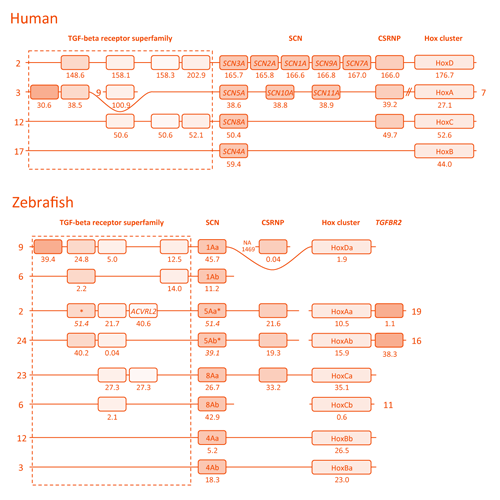>> This post describes my re-analysis of the voltage-gated sodium channel α subunit (SCNA) gene family evolution, based on a previously published study. I have shared the improved results as well as all source files and datasets openly in Figshare, together with a description of the methods: link.
This is probably not my last re-analysis of the same dataset, and I'd want to encourage others to use other phylogenetic methods on our alignments, or use our alignments to analyse their own SCNA sequences.

Last year my research group published a study on the evolution of voltage-gated sodium channel α subunits (see reference below) with me as one of the co-authors. Voltage-gated sodium channels are the proteins that permit the passage of positive charges, in this case sodium ions, across the cell membranes of neurons and thus make it possible for your nerve fibres to fire electrical signals. The α subunits are the very large proteins forming the actual pore that selects only sodium ions and allows them to pass. It's difficult to overestimate how essential they are for the function of the nervous system, and how important their evolution has been for the evolution of neuronal signaling.
Our published study used both sequence-based phylogenetic data and genomic data to clear up the muddled relationships between different subtypes of voltage-gated sodium channels in vertebrates. Us humans, and most other mammals, have ten different types of these α subunits, encoded by genes of the
SCNA family. The different subtypes have acquired different properties and are expressed in different parts of the nervous system and some other tissues in the body where electrical signaling is necessary. One of the subtypes, the product of the
SCN7A gene, has even evolved to such a degree that it's not a channel anymore. It's probably more like a sodium "sensor". There are also specific diseases, different types of epilepsy, seizures and paralyses, that are associated with mutations of the various subtypes.
The same gene family in true bony fishes (
teleosts) encodes up to eight different subtypes, almost as many as the mammalian family. The funny evolutionary twist is that we have evolved almost the same amount of subtypes by completely different mechanisms! In tetrapods, the fleshy-limbed mostly terrestrial group that we belong to, local duplications of genes on the same chromosomes gave rise to new subtypes, while in teleost fishes it was their ancestral duplication of the whole genome that did the same on different chromosomes! You can see the difference in the image below.
 Chromosome organization of the SCNA genes and some of their neighboring genes in humans and zebrafish. Each numbered line represents a different chromosome. The ten human genes are named in a series from SCN1A to SCN11A, skipping the number 6. The duplicates in teleost fish are denoted by the letters "a" and "b".
Chromosome organization of the SCNA genes and some of their neighboring genes in humans and zebrafish. Each numbered line represents a different chromosome. The ten human genes are named in a series from SCN1A to SCN11A, skipping the number 6. The duplicates in teleost fish are denoted by the letters "a" and "b".
This means that when doing comparative studies, it's important to know that while all vertebrate voltage-gated sodium channels have a common origin, they're not always directly related to each other.
Using more powerful and careful methods than we'd used before, I made new evolutionary trees that agree even better with these conclusions. Most of all these new trees are better and clearer examples of the evolutionary relationships between different voltage-gated sodium channel subtypes. You can see figures of the new trees and access all the source files and datasets
in Figshare.


 The day is almost over, but it's still Darwin day! 204 years since the man was born and and an opportunity to "recognize the importance of scientific thinking in our lives and to honor one of humankind’s greatest thinkers", in the words of US Representative Rush Holt as spoken earlier today.
The day is almost over, but it's still Darwin day! 204 years since the man was born and and an opportunity to "recognize the importance of scientific thinking in our lives and to honor one of humankind’s greatest thinkers", in the words of US Representative Rush Holt as spoken earlier today.

 Happy International Darwin day! It's been 203 years since the man was born. As usual, I'm taking the chance to open one (of my several) copies of "Origin" or "Voyage of the Beagle" more or less on a random page and bring out some Darwiniana to celebrate evolution. Check out my previous Darwin entries here.
Happy International Darwin day! It's been 203 years since the man was born. As usual, I'm taking the chance to open one (of my several) copies of "Origin" or "Voyage of the Beagle" more or less on a random page and bring out some Darwiniana to celebrate evolution. Check out my previous Darwin entries here. I've updated my collection of online resources for genomics, sequence analysis and phylogeny - click here or on the "BioInfo" tab above.
I've updated my collection of online resources for genomics, sequence analysis and phylogeny - click here or on the "BioInfo" tab above. 